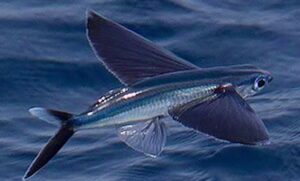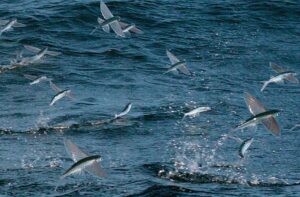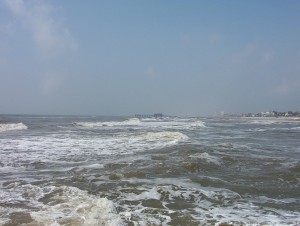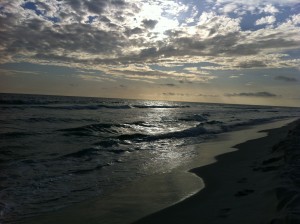atlantic
 Since I am not a fishing fanatic, and in fact, I find the sport…boring, sorry folks, but I do, I’m sure it seems odd for me to write a fish story. Nevertheless, there was a time when I found a certain fish really fascinating. My husband, Bob Schulenberg and I were on a Caribbean cruise for our 25th anniversary, and we loved walking the upper deck of the ship. We often stood looking over the edge looking for dolphin, but it was not dolphin that really made an impact on us, although we did see dolphin. The fish that really caught our eye was the Flying Fish.
Since I am not a fishing fanatic, and in fact, I find the sport…boring, sorry folks, but I do, I’m sure it seems odd for me to write a fish story. Nevertheless, there was a time when I found a certain fish really fascinating. My husband, Bob Schulenberg and I were on a Caribbean cruise for our 25th anniversary, and we loved walking the upper deck of the ship. We often stood looking over the edge looking for dolphin, but it was not dolphin that really made an impact on us, although we did see dolphin. The fish that really caught our eye was the Flying Fish.
Flying fish, also known as Exocoetid is a marine fish in the order Beloniformes class Actinopterygii, known in simple terms as flying fish or flying cod. They are “ray-finned fish with highly modified pectoral fins.” While they are called Flying Fish, the  name is a bit misleading in that they aren’t capable of powered flight. Their fins can’t act as wings. Instead they propel themselves out of the water at speeds of more than 35 miles an hour. Once in the air, their rigid “wings” allow them to glide for up to 650 feet. The wing-like pectoral fins are primarily for gliding. Then, while swimming, the fish hold the fins flat at their sides. Their streamlined bodies reduce drag when the fish are “flying.” However it works, the Flying Fish is a unique and very interesting thing to see…especially when you had no idea that such a thing existed. Another interesting characteristic of the flying fish is its “unevenly forked tail, which has a top lobe that’s shorter than the bottom lobe.” While the Flying Fish looked small from the deck of the ship, they can actually be up to 18 inches long. Nevertheless, they average Flying Fish is 7 to 12 inches.
name is a bit misleading in that they aren’t capable of powered flight. Their fins can’t act as wings. Instead they propel themselves out of the water at speeds of more than 35 miles an hour. Once in the air, their rigid “wings” allow them to glide for up to 650 feet. The wing-like pectoral fins are primarily for gliding. Then, while swimming, the fish hold the fins flat at their sides. Their streamlined bodies reduce drag when the fish are “flying.” However it works, the Flying Fish is a unique and very interesting thing to see…especially when you had no idea that such a thing existed. Another interesting characteristic of the flying fish is its “unevenly forked tail, which has a top lobe that’s shorter than the bottom lobe.” While the Flying Fish looked small from the deck of the ship, they can actually be up to 18 inches long. Nevertheless, they average Flying Fish is 7 to 12 inches.
Another thing I didn’t know is that there are approximately 40 species of flying fish. They are tropical fish and  can be seen off both the Atlantic and Pacific coasts of the United States. They are also found in the Atlantic, Pacific, and Indian oceans. most flying fish live in open oceans, but some live on the outskirts of coral reefs.
can be seen off both the Atlantic and Pacific coasts of the United States. They are also found in the Atlantic, Pacific, and Indian oceans. most flying fish live in open oceans, but some live on the outskirts of coral reefs.
I don’t claim to know all the fish in the sea, but I had no idea that such a thing existed. At first we thought they were birds. We couldn’t figure out how these “little birds” could be flying around so far out to sea, then we found out that they were actually fish. I’ll never forget how cool it was to watch them. It was a highlight of the cruise…very strange for a non-fisherman, I know.
 As airplanes became an accepted form of transportation, people began to consider traveling further and further. Of course, those first airplanes could never have made the flight across the ocean, but these days planes fly that far with ease. Still, someone had to be brave enough to take that first flight across the ocean. Someone had to trust their plane enough to make the attempt. British aviators John Alcock and Arthur Brown decided to be the first to make that leap when they made the first non-stop transatlantic flight in June 1919. Their plane was a modified First World War Vickers Vimy bomber. They flew from Saint John’s, Newfoundland to Clifden, Connemara, County Galway, Ireland. Like most accomplishments, the competition was fierce, and there had to be a reward for the winner. The Secretary of State for Air, Winston Churchill, presented them with the Daily Mail prize for the first crossing of the Atlantic Ocean by airplane in “less than 72 consecutive hours”. A small amount of mail was carried on the flight, making it the first transatlantic airmail flight. The two aviators were awarded the honour of Knight Commander of the Most Excellent Order of the British Empire a week later by King George V at Windsor Castle.
As airplanes became an accepted form of transportation, people began to consider traveling further and further. Of course, those first airplanes could never have made the flight across the ocean, but these days planes fly that far with ease. Still, someone had to be brave enough to take that first flight across the ocean. Someone had to trust their plane enough to make the attempt. British aviators John Alcock and Arthur Brown decided to be the first to make that leap when they made the first non-stop transatlantic flight in June 1919. Their plane was a modified First World War Vickers Vimy bomber. They flew from Saint John’s, Newfoundland to Clifden, Connemara, County Galway, Ireland. Like most accomplishments, the competition was fierce, and there had to be a reward for the winner. The Secretary of State for Air, Winston Churchill, presented them with the Daily Mail prize for the first crossing of the Atlantic Ocean by airplane in “less than 72 consecutive hours”. A small amount of mail was carried on the flight, making it the first transatlantic airmail flight. The two aviators were awarded the honour of Knight Commander of the Most Excellent Order of the British Empire a week later by King George V at Windsor Castle.
As with any record, there is always room for improvement. The first flight took place with two people on board, so on Ma 21, 1927, at age 25, Charles Lindbergh went from being an unknown United States Air Mail pilot, to world fame instantly, by making his Orteig Prize winning nonstop flight from Long Island, New York to Paris. He covered the 33½ hour, 3,600 miles alone in a single-engine Ryan monoplane called the Spirit of Saint Louis.  The plane was build for this flight. This was the first solo transatlantic flight, and the first non-stop flight between North America and mainland Europe. I wonder what he was thinking as he flew for 33½ hours alone over the ocean. He had to keep himself awake, and on course. There was no one else to do it. Most of us have a hard time staying awake for more than 17 or 18 hours, much less 33½ hours. It was an amazing feat, and one for which the fame he gained was well deserved.
The plane was build for this flight. This was the first solo transatlantic flight, and the first non-stop flight between North America and mainland Europe. I wonder what he was thinking as he flew for 33½ hours alone over the ocean. He had to keep himself awake, and on course. There was no one else to do it. Most of us have a hard time staying awake for more than 17 or 18 hours, much less 33½ hours. It was an amazing feat, and one for which the fame he gained was well deserved.
As with any record, someone had to beat it or improve on it or change it in some way. The record held until May 21, 1932, when Amelia Earhart became the first woman to make a solo air crossing of the Atlantic Ocean, from Newfoundland to Ireland. As with Charles Lindbergh, I wondered how Amelia stayed awake for all those hours, and what she was thinking as she flew along…alone for all those hours. I’m sure there was excitement in the extreme, but I’m sure she was weary after the flight was over too.
 I will never forget the first time I saw the ocean. I can’t tell you the exact spot, unfortunately, but it was along the coast of Maine. Our family had taken a trip to visit my sister, Cheryl Masterson whose husband was stationed in Plattsburgh, New York at the time. While we were there, the whole family took a trip down the east coast. It was amazing. That first ocean view was one of the most awe inspiring views I have ever seen, as I’m sure anyone who has seen the ocean would agree. It is difficult to comprehend such a vast expanse of water, with no visible land on the other side. There are the great lakes too, of course, and they do give a feel of an ocean, but you know they are just lakes, and as quickly as it appeared, that feeling of unbelievable vastness passes. But, the ocean…that view is one that will always have a place in my memory files.
I will never forget the first time I saw the ocean. I can’t tell you the exact spot, unfortunately, but it was along the coast of Maine. Our family had taken a trip to visit my sister, Cheryl Masterson whose husband was stationed in Plattsburgh, New York at the time. While we were there, the whole family took a trip down the east coast. It was amazing. That first ocean view was one of the most awe inspiring views I have ever seen, as I’m sure anyone who has seen the ocean would agree. It is difficult to comprehend such a vast expanse of water, with no visible land on the other side. There are the great lakes too, of course, and they do give a feel of an ocean, but you know they are just lakes, and as quickly as it appeared, that feeling of unbelievable vastness passes. But, the ocean…that view is one that will always have a place in my memory files.
I remember too, that it was in Maine that I hade my first taste of lobster. Oh my gosh…it was  heavenly. Many people say that the experience of eating lobster on the coast probably ruined lobster for me, because it just doesn’t taste the same anywhere else. That may be true, but lobster is still heavenly, and all I can say if that I wish the price for it wasn’t so far out of this world. There are so many experiences that are only enhanced by their natural habitat, and while lobster eating is one of them, I’ll do my best to struggle through it, anytime I get the chance.
heavenly. Many people say that the experience of eating lobster on the coast probably ruined lobster for me, because it just doesn’t taste the same anywhere else. That may be true, but lobster is still heavenly, and all I can say if that I wish the price for it wasn’t so far out of this world. There are so many experiences that are only enhanced by their natural habitat, and while lobster eating is one of them, I’ll do my best to struggle through it, anytime I get the chance.
While my husband, Bob and I have seen the Atlantic and Pacific Oceans, the Caribbean Sea, the Gulf of Mexico, and now, the Gulf of Alaska, and each of those experiences have been awesome, they couldn’t compare to the way I felt at my first ocean view. Obviously I was a younger girl then, and while I was pretty well traveled as a child, there are simply some sights that tower over others in your mind. I wasn’t so young at that first ocean view,  exactly, at 15 years of age, but somehow the view of the ocean made me feel like I was younger and smaller. Its vastness was so much to take in. I wondered what things were on the other side, and how many desert islands were in between this side and that side. I wondered about the shipwrecks there might be from days of pirates and hurricanes, and about the fish that lived in the ocean. All were things I would probably never know about…or would I? Perhaps with a little research, the events of the ocean’s past could open up and I could be privy to the secrets that lie beneath those vast expanses of beautiful blue water too.
exactly, at 15 years of age, but somehow the view of the ocean made me feel like I was younger and smaller. Its vastness was so much to take in. I wondered what things were on the other side, and how many desert islands were in between this side and that side. I wondered about the shipwrecks there might be from days of pirates and hurricanes, and about the fish that lived in the ocean. All were things I would probably never know about…or would I? Perhaps with a little research, the events of the ocean’s past could open up and I could be privy to the secrets that lie beneath those vast expanses of beautiful blue water too.
 Most little kids don’t really like fish much, unless it is in the form of fish sticks, and I don’t think fish sticks existed when my sister, Cheryl and I were little girls. I don’t know why Cheryl wanted to have her picture taken with all these fish, or if my mom just set her there because she would be a good point of reference to show just how many fish there were here, but I do know that it would have been a good thing that the fish were dead already, because if they had been flipping around, Cheryl would have probably been freaking out for sure…I know I would have, but then I was a baby. The fish were Smelt, and there were lots of them.
Most little kids don’t really like fish much, unless it is in the form of fish sticks, and I don’t think fish sticks existed when my sister, Cheryl and I were little girls. I don’t know why Cheryl wanted to have her picture taken with all these fish, or if my mom just set her there because she would be a good point of reference to show just how many fish there were here, but I do know that it would have been a good thing that the fish were dead already, because if they had been flipping around, Cheryl would have probably been freaking out for sure…I know I would have, but then I was a baby. The fish were Smelt, and there were lots of them.
Rainbow Smelt, which are silver-colored fish about 6 to 9 inches long, are not native to Lake Superior, but rather to the Atlantic and Pacific Oceans. Smelt entered the Great Lakes accidentally in 1912 when they escaped from an inland lake in Michigan where they had been stocked as forage fish. After that, they quickly spread throughout Lake Michigan and were finally discovered in Lake Superior in 1946. By that time, Sea Lamprey, which had also invaded Lake Superior, had begun reducing the number of native lake Trout, so there were far less Trout to eat the Smelt and they began to rapidly increase in number. Every year in mid-April, the Smelt head for the streams to lay their eggs. They are light sensitive, so smelting must be done at night. The best place to go smelting is at the mouth of the streams where they enter the Lakes. The rapids make it more difficult for the fish to jump over them into the stream, and so they are in abundance at that place. Smelting was a big deal at the time we were living in Superior, Wisconsin, when Cheryl and I were little girls.
When April came around in 1957, Mom, Dad, Uncle Bill, and Aunt Doris took Cheryl, me, and our cousin, Pam, and went smelting. Of course, the women pretty much just watched the proceedings, while Dad and Uncle Bill gathered up the buckets of fish that would be our haul for the evening. It was a good run, and the amount of fish they took home was amazing. The fish were then cleaned and frozen for lots of good eating down the road. I’ve never been smelting, at least where I actually participated, but I can imagine that it was pretty exciting to see all those fish all at once. usually think of fishing as a lazy day sport, and normally it is, but during a smelting run, it sounds pretty exciting to me!!

